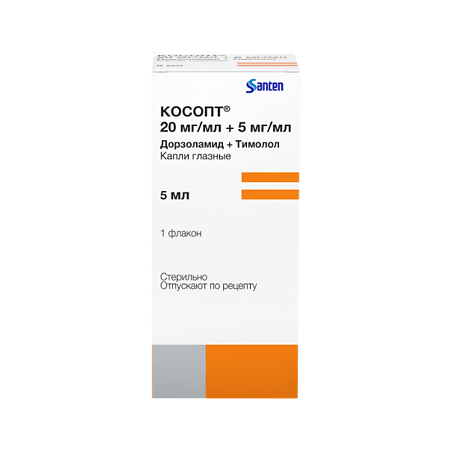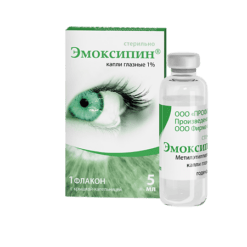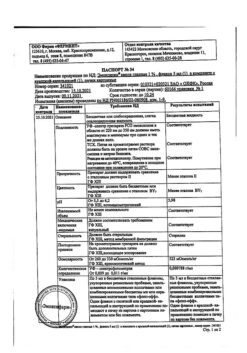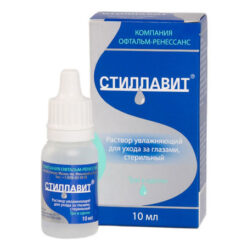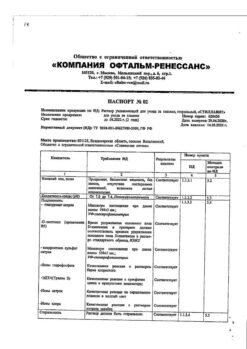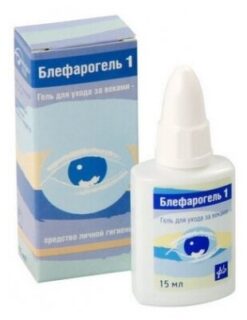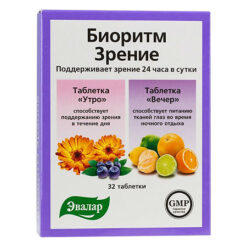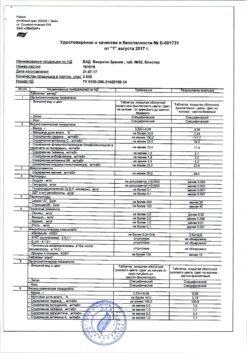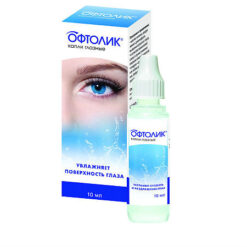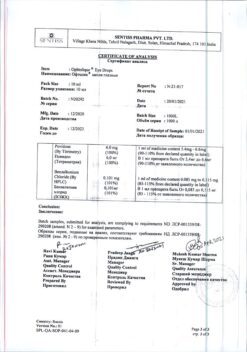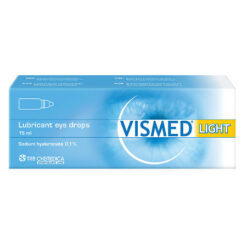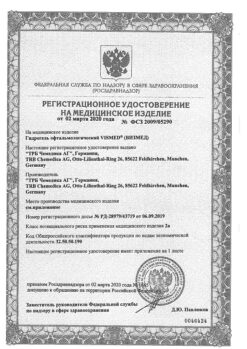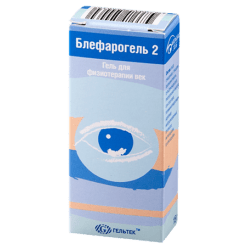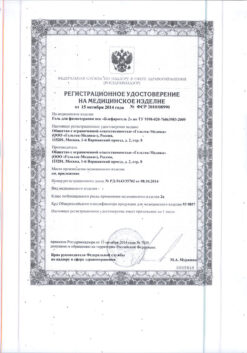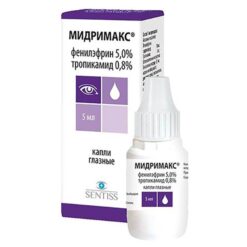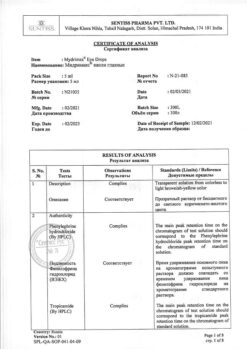No products in the cart.
Cosopt, eye drops 20 mg/ml+5 mg/ml 5 ml
€33.72 €28.10
Description
COSOPT is used to treat elevated intraocular pressure in open-angle glaucoma and pseudoexfoliative glaucoma when monotherapy is not effective or ophthalmohypertension when treatment with beta-adrenoblockers is inadequate.
Active ingredient
Active ingredient
Composition
Composition
1 ml contains
Active ingredients:
20 mg dorzolamide base (22.26 mg dorzolamide hydrochloride) and 5 mg timolol base (6.83 mg timolol maleate).
Auxiliary substances:
benzalkonium chloride (as 50% benzalkonium chloride solution) 0.075 mg (0.15 mg),
sodium citrate 2.94 mg,
Mannitol 16.00 mg,
Guetellose (hydroxyethylcellulose) 4.75 mg,
1M sodium hydroxide solution q.s. to pH 5.6,
water for injection q.s. to 1 ml.
How to take, the dosage
How to take, the dosage
COSOPT is administered in ONE drop into the conjunctival sac of the affected eye (or both eyes) twice daily.
If COSOPT is prescribed as a replacement for another ophthalmic drug to treat glaucoma, the latter must be discontinued the day before starting COSOPT therapy.
When used together with another topical ophthalmic drug, COSOPT should be used at least 10 minutes apart.
In case of nasolacrimal occlusion (eyelid closure) for 2 minutes after the drug injection, its systemic absorption is reduced, which may lead to increased local action.
COSOPT is a sterile solution, so patients should be instructed on how to use the bottle correctly.
Interaction
Interaction
Specific studies of interaction of COSOPT with other drugs have not been conducted. Nevertheless, there is a possibility of increased hypotensive effect and/or marked bradycardia when using timolol maleate ophthalmic solution and systemic calcium channel blockers together, catecholamine-wasting agents, beta-adrenoblockers, antiarrhythmic agents (including amiodarone), foxglove glycosides, parasympathomimetics, opioid analgesics and monoamine oxidase inhibitors (MAOIs).
When timolol and CYP2D6 isoenzyme inhibitors (e.g., quinidine or selective serotonin reuptake inhibitors) are used together, potentiated effects of systemic beta-adrenoreceptor blockade (e.g., decreased heart rate, depression) have been reported.
While the carboanhydrase inhibitor dorzolamide in COSOPT is used topically, it can penetrate into the systemic bloodstream. No disorders of acid-base balance have been identified in clinical studies of dorzolamide hydrochloride ophthalmic solution. Nevertheless, these disorders are known in systemic use of carboanhydrase inhibitors and in some cases may be affected by interactions with other drugs (e.g., toxicity associated with high-dose salicylate therapy). As a consequence, the possibility of these interactions should be taken into account in patients receiving COSOPT.
Systemic beta-adrenoblockers may increase the hypoglycemic effect of antidiabetic drugs and hypertension, which is the effect of clonidine (clopheline) withdrawal.
While there are minimal or no effects on the pupil with COSOPT monotherapy, there have been isolated descriptions of mydriasis when using timolol maleate and adrenaline together.
There is a possibility that the known systemic effects of carboenhydrase inhibition may be enhanced with the combined use of local and systemic carboenhydrase inhibitors. Since there are no data on the use of this combination, co-administration of COSOPT and systemic carboangiidrase inhibitors is not recommended.
Special Instructions
Special Instructions
The first signs or symptoms of heart failure should be discontinued.
Contact lens use
The preservative benzalkonium chloride is a component of COSOPT and may cause eye irritation. The lenses should be removed and put on again not earlier than 15 minutes after the application of the preparation. Benzalkonium chloride can discolor soft contact lenses.
Impacts on driving and operating machinery
When using COSOPT, side effects may occur (see side effects), which in some patients may make it difficult to drive or operate complex machinery.
Contraindications
Contraindications
WARNING
In common with other ophthalmic drugs used topically, COSOPT may be absorbed into the systemic circulation. Because the constituent thymolol is a beta-adrenoblocker, adverse reactions that occur with systemic use of beta-adrenoblockers may occur with topical use of the drug.
Cardiovascular and respiratory reactions
Patients with a history of cardiovascular disease, including heart failure, should be closely monitored for signs of worsening of these conditions. The heart rate should be monitored in these patients.
Patients with grade I heart block should be prescribed beta-adrenoblockers with caution because of their ability to slow pulse conduction.
There have been reports of fatal bronchospasm in patients with bronchial asthma and cases of fatal heart failure with timolol maleate eye drops.
Patients with mild to moderate chronic obstructive pulmonary disease (COPD) should use COSOPT with caution and only if the anticipated benefit of treatment exceeds the potential risk.
The drug should be used with caution in patients with severe peripheral circulatory disorders (severe Raynaud’s disease or Raynaud’s syndrome).
Hypoglycemia in patients with diabetes mellitus
.Beta-adrenoblockers should be administered with caution in patients predisposed to spontaneous hypoglycemia or in patients with diabetes mellitus (especially labile diabetes mellitus), while taking insulin or oral hypoglycemic agents. Beta-adrenoblockers may mask signs and symptoms of acute hypoglycemia.
Thyrotoxicosis
Beta-adrenoblockers may mask some clinical signs of hyperthyroidism (e.g., tachycardia). If thyrotoxicosis is suspected, patients should be closely monitored. Abrupt withdrawal of beta-adrenoblockers should be avoided because of the risk of thyrotoxic crisis.
Anesthesia in Surgery
There is no proven need to withdraw beta-adrenoblockers if extensive surgery is to be performed. If necessary during surgery, the effects of beta-adrenoblockers can be managed with sufficient doses of adrenomimetics.
Hepatic impairment
There have been no studies of COSOPT use in patients with hepatic impairment; therefore, the drug should be used with caution in these patients.
Allergies and hypersensitivity
In common with other ophthalmic topicals, COSOPT may penetrate the systemic bloodstream. The dorzolamide in the drug is a sulfonamide. Thus, adverse reactions that have been identified when using sulfonamides systemically may be noted when using the drug topically (Stevens-Johnson syndrome and toxic epidermal necrolysis). If there are signs of serious hypersensitivity reactions the drug should be discontinued.
When treating with beta-adrenoblockers in patients with atopy or severe anaphylactic reactions to various allergens in anamnesis there may be increase in response if there is repeated contact with these allergens. In this group of patients the administration of epinephrine in a standard therapeutic dose used for relief of allergic reactions may not be effective.
Companion therapy
When COSOPT is used in patients who are taking systemic beta-adrenoblockers, possible mutual enhancement of pharmacological actions of the drugs with respect to both the known systemic effects of beta-adrenoblockers and decrease in intraocular pressure should be considered. Co-administration of COSOPT with other beta-adrenoblockers is not recommended.
Cessation of treatment
If the topical use of timolol is to be withdrawn, as with systemic beta-adrenoblockers, therapy in patients with coronary heart disease should be terminated gradually.
Corneal disorders
The beta-adrenoblockers used in ophthalmology may cause dry eye. Patients with corneal disorders should use the drug with caution.
Patients with low endothelial cell counts have an increased risk of corneal edema.
Ureinary stone disease
The use of systemic carboanhydrase inhibitors may lead to an imbalance of acid-base balance and may be accompanied by urolithiasis, especially in patients with a history of urolithiasis. During the use of COSOPT such disorders were not observed, reports of urolithiasis were rare. Since COSOPT contains a carboenhydrase inhibitor which may be absorbed when applied topically and penetrate into the systemic blood flow, the risk of urolithiasis in patients with a history of urolithiasis may increase when treated with COSOPT.
Different
Patients with acute closed angle glaucoma require other therapeutic measures in addition to the prescription of agents to reduce intraocular pressure. There have been no studies of COSOPT in patients with acute closed-angle glaucoma.
Application in the elderly
49% of patients in clinical trials of COSOPT were aged 65 years or older and 13% of patients were aged 75 years or older. There was no difference in the efficacy and safety of the drug in these age groups compared to younger patients. However, the possibility of greater sensitivity to the drug in some older patients should not be excluded.
Side effects
Side effects
COSOPT is generally well tolerated. In clinical trials, no adverse effects unique to this combination drug were observed. Adverse reactions were limited to the already known side effects of dorzolamide hydrochloride and/or timolol maleate. In general, systemic side effects were mild and did not lead to drug withdrawal. In clinical trials, COSOPT was administered to 1,035 patients. Approximately 2.4% of patients were discontinued due to local ocular adverse reactions. In approximately 1.2% of patients, the drug was discontinued because of local allergic reactions. Among the most common side effects were burning or itching sensation in the eye, taste distortion, corneal erosions, conjunctival injection, blurred vision, and lacrimation.
In the post-registration follow-up period, the following adverse events were reported: dyspnea, respiratory depression, contact dermatitis, bradycardia, atrioventricular block, chorioid detachment, nausea, Stevens-Johnson syndrome, and toxic epidermal necrolysis. Cases of corneal edema and irreversible corneal destruction in patients with chronic corneal defects and/or who have undergone intraocular surgery have been reported.
The following possible side effects of the drug components are known:
Dorzolamide hydrochloride:
.Headache, eyelid inflammation, eyelid irritation and flaking, asthenia/fatigue, iridocyclitis, rash, dizziness, paresthesias, pitting keratitis, transient myopia (resolving after drug withdrawal), systemic allergic reactions including angioedema, bronchospasm, urtic rash and itching, nosebleed, irritation of the throat, dry mouth.
Timolol maleate (topical use):
In the eye side, conjunctivitis, blepharitis, keratitis, decreased corneal sensitivity, dryness; visual disturbances including changes in the refractive power of the eye (in some cases due to myotics withdrawal), diplopia, ptosis; tinnitus, arrhythmia, hypotension, syncope, cardiovascular disorders, rhythm disturbances, cardiac arrest, edema, claudication, paresthesias, Raynaud’s phenomenon, decreased temperature of hands and feet, bronchospasm (mainly in patients with previous bronchoobstructive pathology), cough, headache, asthenia, fatigue, chest pain, alopecia, psoriasis-like rashes or exacerbation of psoriasis; signs and symptoms of an allergic reaction, including anaphylaxis, angioedema, urticarial rash, localized or generalized rash; dizziness; depression, insomnia, nightmares, memory loss, myasthenia gravis, diarrhea, dyspepsia, dry mouth, abdominal pain, decreased libido, Peyronie’s disease, sexual dysfunction, systemic lupus erythematosus, myalgia.
Timolol maleate (systemic use):
.Limb pain, decreased exercise tolerance, grade II and III atrioventricular block, sinoauricular block, pulmonary edema, worsening arterial insufficiency, worsening angina, vasodilation, vomiting, hyperglycemia, hypoglycemia, itchy skin, increased sweating, exfoliative dermatitis, arthralgia, dizziness, weakness, decreased concentration, increased somnolence, nonthrombocytopenic purpura, wheezing, impotence, urinary disorders.
In systemic use of thymolol maleate, clinically significant changes in standard laboratory parameters have been observed very rarely. Mild increases in residual nitrogen, potassium, uric acid and plasma triglycerides; mild decreases in hemoglobin, hematocrit, high-density lipoprotein cholesterol (XC HDL) have been described, but these changes were not progressive and were not clinically manifest.
The use of beta-adrenoblockers may cause exacerbation of pseudoparalytic myasthenia gravis.
Overdose
Overdose
Pregnancy use
Pregnancy use
Do not take COSOPT during pregnancy and breastfeeding.
Dorzolamide
Information on the use of dorzolamide in pregnant women is lacking. It is not known whether dorzolamide penetrates the breast milk of lactating women.
The teratogenic effects of dorzolamide at doses toxic to pregnant females have been identified in studies on rats. Reduced body weight gain was found in calves of lactating female rats treated with dorzolamide.
Timolol
Information on the use of timolol in pregnant women is insufficient. Timolol should not be taken during pregnancy unless the use of timolol is vital.
Epidemiological studies have found no effect of oral beta-adrenoblockers on the development of birth defects, but the risk of intrauterine growth retardation has been identified. In addition, signs and symptoms of beta-adrenoreceptor blockade (bradycardia, hypotension, respiratory failure, and hypoglycemia) were found in newborns when beta-adrenoblockers were used before delivery. If the drug was used before delivery, the condition of the newborn should be closely monitored during the first days of life.
Beta-adrenoblockers penetrate into breast milk. The treating physician should decide whether to stop breastfeeding or to discontinue the drug, taking into account the potential serious side effects on the breastfed infant and the benefit of the drug to the mother.
Beta-adrenoblockers penetrate into breast milk.
Similarities
Similarities
Additional information
| Shelf life | 2 years |
|---|---|
| Conditions of storage | In a light-protected place, at a temperature not exceeding 25 °C |
| Manufacturer | Santen Pharmaceutical Co. Noto Plant, Japan |
| Medication form | eye drops |
| Brand | Santen Pharmaceutical Co. Noto Plant |
Related products
Buy Cosopt, eye drops 20 mg/ml+5 mg/ml 5 ml with delivery to USA, UK, Europe and over 120 other countries.

